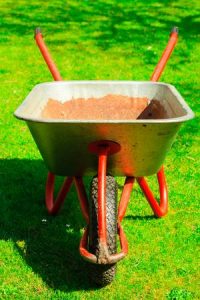 Whilst you can buy proprietary lawn feed and lawn ‘Weed & Feed’ these can work out quite expensive and there is a major problem with ‘Weed & Feed’. The selective herbicides used in lawn weedkillers are very effective but they are retained in the cuttings. If you then go on to use those cuttings as a mulch or in a bean trench, the chances are they’ll kill off your crop.
Whilst you can buy proprietary lawn feed and lawn ‘Weed & Feed’ these can work out quite expensive and there is a major problem with ‘Weed & Feed’. The selective herbicides used in lawn weedkillers are very effective but they are retained in the cuttings. If you then go on to use those cuttings as a mulch or in a bean trench, the chances are they’ll kill off your crop.
Even composting isn’t a guarantee that the herbicide will break down. If you do use these products, read the fine print on the bottle very carefully.
Making your own lawn sands and feeds will save you money and not produce any nasty surprises if you use the mowings. When mixing and applying wear gloves, of course, or the great health and safety man will get you!
Home Made Lawn Sand Mix Recipe
Whilst this is admittedly not as effective at weed killing as a herbicide, it will knock the weeds back and strengthen the grass helping to crowd out the weeds.
- 19 parts by weight Dry Ordinary Builders Sand (from builders merchant)
- 7 parts by weight Sulphate of Ammonia (Garden Centre or Horticultural Supplier)
- 3 parts by weight Sulphate of Iron (Garden Centre or Horticultural Supplier)
It doesn’t matter whether you use ounces or grams, pounds or kilos as long as you stick to the ratio 19:7:3 and mix well. It is critical that the sand is dry and the mixture is kept dry until use.
Apply to the lawn at a rate of 150 grams per square metre. Drop a pinch into the centre of any dandelions or other clumps of weeds. It can help to mark out a bit of the lawn in square metres and weigh a small handful of the sand. This gets your eye in. I find I apply about 100 grams in a handful.
It’s best applied the day before rain is expected or apply and the next morning give the lawn a light watering to wash the sand in a bit.
Spring Lawn Fertiliser Sand Mix Recipe
If you have a moss problem then add sulphate of iron as in lawn sand recipe above.
- 19 parts by weight Dry Ordinary Builders Sand (from builders merchant)
- 7 parts by weight Sulphate of Ammonia (Garden Centre or Horticultural Supplier)
- 3 parts by weight Superphosphate (Garden Centre or Horticultural Supplier)
If you use Rock Phosphate drop to 2 parts by weight
Apply to the lawn at a rate of 150 grams per square metre.
Summer Lawn Fertiliser Sand Mix Recipe
- 25 parts by weight Dry Ordinary Builders Sand (from builders merchant)
- 7 parts by weight Sulphate of Ammonia (Garden Centre or Horticultural Supplier)
- 3 parts by weight Superphosphate (Garden Centre or Horticultural Supplier)
If you use Rock Phosphate drop to 2 parts by weight
Apply to the lawn at a rate of 150 grams per square metre.
Home Made Liquid Lawn Feed Recipe
This mix is convenient when the weather is dry and especially in a hosepipe ban.
- 30 gr Sulphate of Ammonia
- 15 gr Superphosphate
Mix into 10 litres of water apply at a rate of 10 litres per square metre with a coarse rose on the can. Apply at evening time so any dew that might form at night helps wash it in.
Autumn Lawn Fertiliser Mix Recipe
- 20 parts sand by weight
- 6 parts superphosphate by weight
- 1 part sulphate of potash or 5 parts wood ash by weight
Apply at 150 grams per square metre
The superphosphate will encourage root growth and the potash will help harden the grass against freezing frosts.
Liquid Moss Killer Recipe
Take 35 grams of Sulphate of Iron and mix into 1 litre of hot water. When completely dissolved add into 9 litres of water. You may find it easier to mix half a litre into 5 litres twice depending on the size of your watering can.
Apply with a fine rose onto the patches of moss.
Lawn Top Dressing Mix
Lawn top dressings used to incorporate peat which is becoming hard to find but well aged leafmould, especially if run through a shredder will provide a green replacement.
You can purchase fine topsoil, either in 20Kg bags or in large one ton bags. Alternatively, make your own loam by stacking some lawn turf grass side down, covered with a tarpaulin for a year. Then crumble it finely (some shredders can cope with this) and run through a riddle (large garden sieve) to get out any stones.
Finally buy some washed fine sand from the builders merchant. Mix 2 buckets of leafmould with 4 buckets of sieved loam or topsoil and add sand as follows:
- On heavy soils 4 buckets
- On loamy soils 2 buckets
- On sandy soils 1 bucket
Ideally this should be done each year but it’s a lot of work. If you can spare the time though it is well worth it. Even if you can only do it every two or three years, it’s a good idea.
Lawn Care Guides
- Artificial Grass Can be the Answer
- Renovating a Lawn Restoring an Old or Damaged Lawn
- Monthly Lawn Care Guide, Through the Year Lawn Guide
- Lawn Sand & Feed Mixes, Top Dressing, Moss Killer Recipe
- Removing & Controlling Lawn Moss Improve Your Lawn
- How to Lay Turf – Laying new turf to replace a lawn



